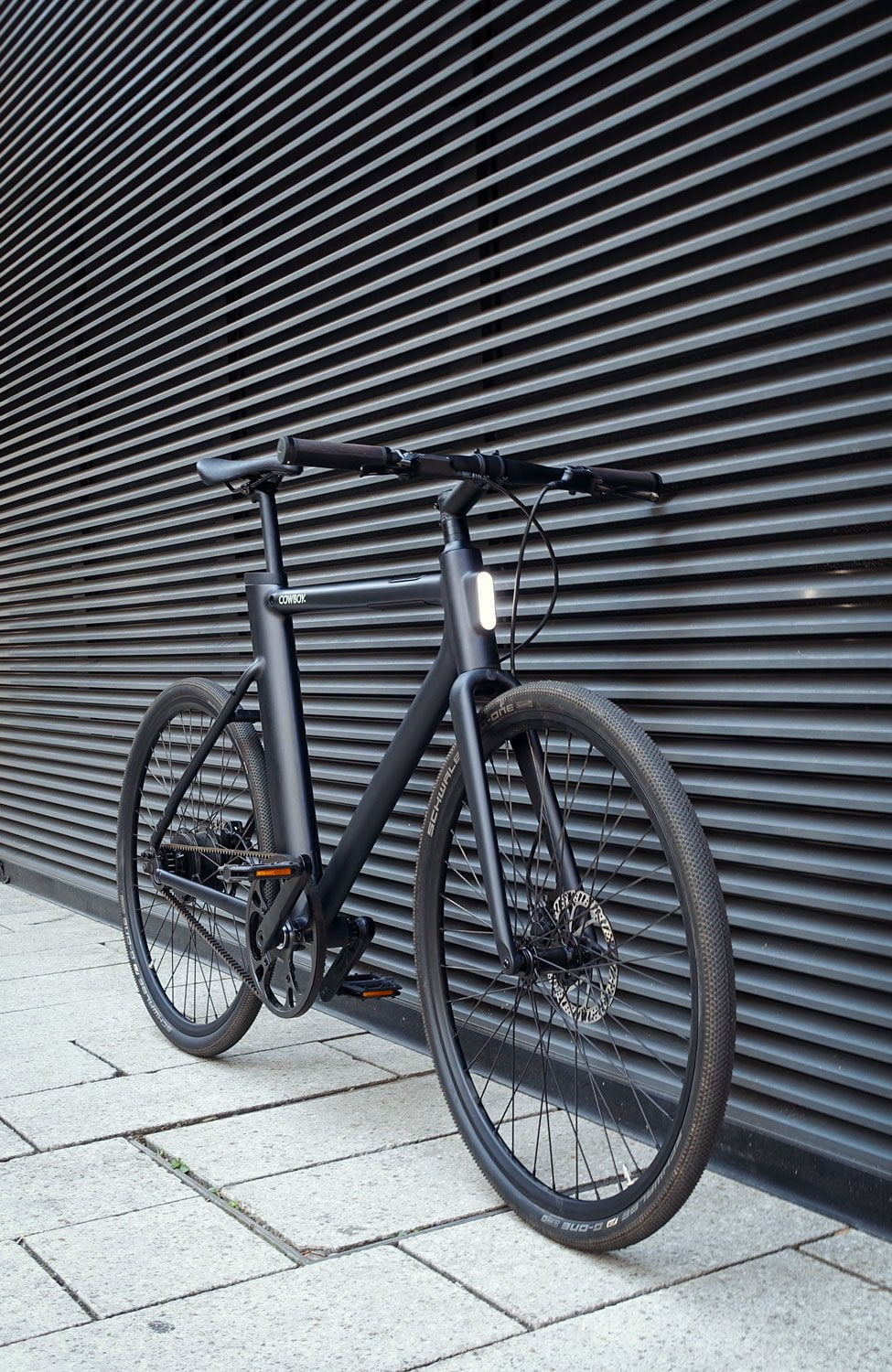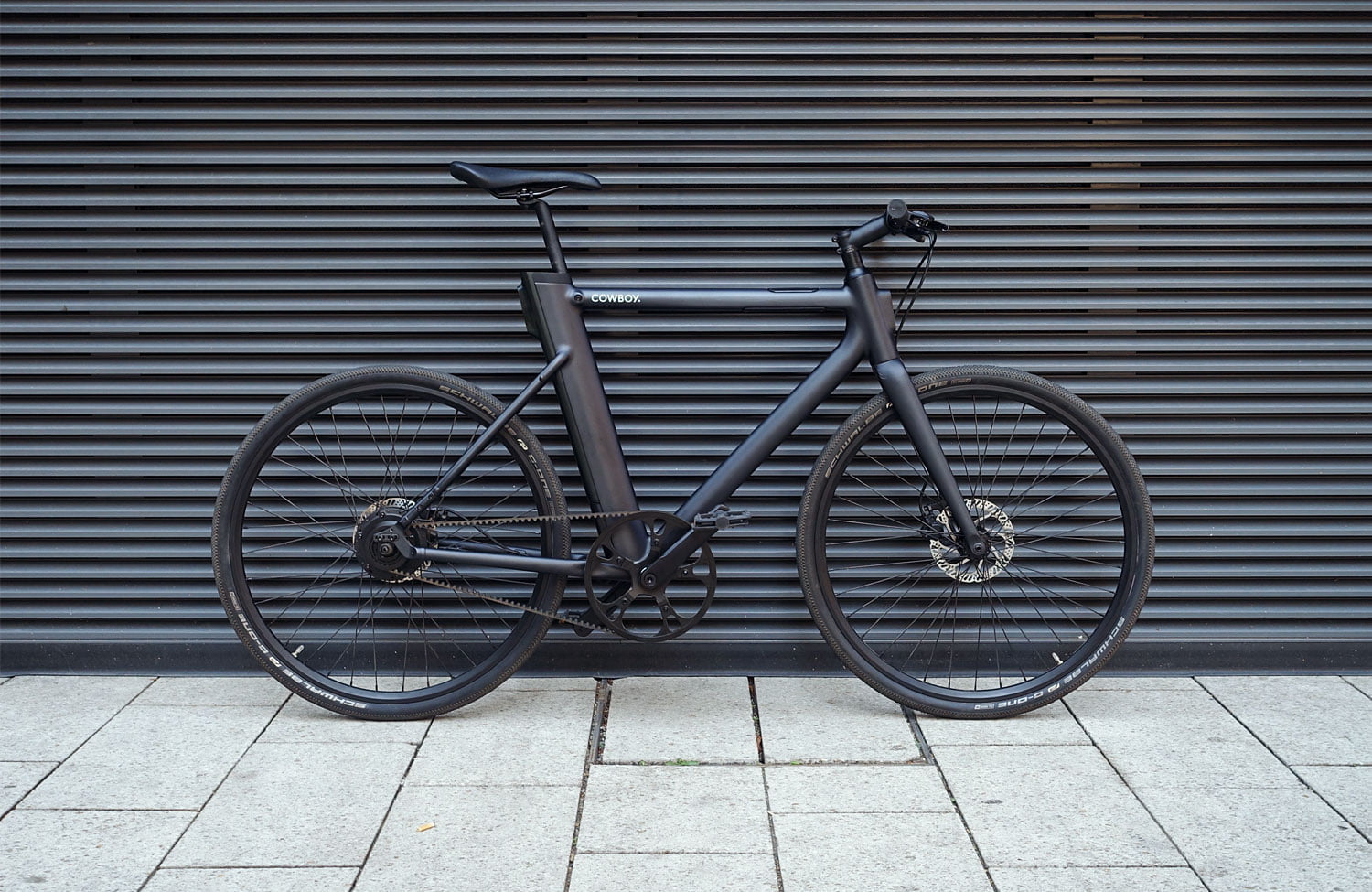Only a few other new urban bikes have caused as much hype this year as the Cowboy Bike. The bike was already on display at the Eurobike 2017 bike show, where the newcomer won the prestigious Eurobike Award. Since then, the bike has been fully developed and is now available for regular orders via the Cowboy website.

Particularly interesting is this bike due to some outstanding features. First you can name the removable battery, which is docked to the rear of the seat tube and houses the rear light. For comparison: On almost all other electric urban bikes the battery sits in the down tube and is usually not removable (so the bike has to be taken to the next socket to be charged). The mentioned rear light complements the front light, which is integrated in the frame – this is also an uncommon solution, which is known only from Vanmoof. Like some other models, the Cowboy is also designed as a single-speed bike without gears and with a belt drive. The implementation with a huge 68-tooth chainring is a novelty and an eye-catcher at the same time. The GPS module, on the other hand, is invisible from the outside, so that the location of the bike can always be tracked. You can do this with the cowboy app, which is deeply integrated with the bike – even to the point that the electric drive can only be activated via smartphone. Ultimately, the price of the bike also attracts attention: The Cowboy can be ordered online for 1,990 Euros – almost a bargain for a bike with this features. Whether the high expectations will be fulfilled in reality, this test will show.
First of all it should be mentioned that the model tested here is a 2018 version. However, the differences to the current model are small and mainly concern the tires and the battery (which has a higher capacity in the 2019 models). The cover of the battery indicator on the top tube of the 2019 models is matt instead of high-gloss.
Design
The already mentioned characteristics of the Cowboy are also reflected in the design of the bike: the seat tube is necessarily much more voluminous than those of conventional bikes due to the integrated battery. This looks a bit unusual at first glance, but then it fits quite well – because its tapered shape doesn’t make it look too thick. Visually there is also a parallel to the head tube with the sporty straight fork.
The rather sporty orientation of the cowboy becomes visible beside the huge chainring of the singlespeed-drive also at the handlebar, which is relatively narrow with about 55 cm. The integrated lighting is arranged vertically at the front and rear; when switched off, the two lights can only be noticed as white elements. The rest of the bike is completely black, which gives the cowboy a minimalist and rather radical character. Apart from the cowboy lettering on the top tube, the bike is also free of other lettering and logos, which further enhances the clean look.
Another interesting detail is the LED element on the top tube: what at first glance looks like an ultra-modern control element simply turns out to be a cover for five LEDs that indicate the capacity of the battery.
Features
Like most Urban E-Bikes of this type, the Cowboy is also equipped with a hub motor in the rear wheel. At 36V it has the usual 250W continuous power and a maximum torque of 30 Nm. The control is done by a torque sensor, which should provide a natural riding feeling. If you pedal hard, you get a lot of support from the motor; if you pedal weakly, the motor also keeps a low level. Transmission of power is done via a toothed belt system, the manufacturer of this system is not specified by Cowboy. So the Gates Carbon Drive, which has almost become an industry standard, is not used here. The gear ratio is quite long with 68 teeth in front and 22 teeth at the back and is designed for a high top speed. The fork and frame of the bike are made of aluminium, the weight is 16.1 kg according to Cowboy (the test bike weighed 16.5 kg, the difference may be due to the different tires).
The removable battery has a capacity of 360Wh and uses a relatively new cell type in the format 21700. The range should be up to 70 km depending on the driving style, a full battery charge lasts 3.5 hours. The battery is lockable via an integrated lock to prevent theft.
The 2019 model uses 42 mm wide Panaracer Gravelking tyres in 27.5″ format. The hydraulic brakes from Tektro, front and rear each with a 160 mm brake disc, ensure deceleration. You will look in vain for a bell, mudguards, kickstand or a porter.
Operation
Cowboy focuses entirely on connectivity with the smartphone. This goes so far that the electrical assistance cannot be activated at all without an app – which also means that the bike operates entirely without a button. The absence of a gear change makes this minimalist control concept perfect. Regarding the battery, it should be mentioned that it can only be recharged when removed. So the charger cannot be connected directly to the bike, which is no real problem – the battery can be easily taken out of the bike.
All settings are made in the Cowboy app: the bike can be turned on and off and the motor and lights can be activated. In addition, the app shows the location of the bike via GPS, for what a GPS module is built into the bike (by the way, there are no running costs for this). In addition, every ride is recorded and shown with route, duration and time. The fact that the whole app is also beautifully designed and easy to use completes the extremely positive impression of the app.
A special feature of the app is the ability to control the assistance provided by the electrical system: According to the pedelec regulations, the motor must be turned off at a speed of 25 km/h or higher. But there is an option in the app called “Offroad Mode”, where the assistance can be set up to 30 km/h – of course with the note that this can only be done on private property and not in public traffic. It remains to be seen how long this function will remain available. Similar things have been seen on Coboc and Ampler, but they have been removed with increasing popularity and possibly due to the pressure from regulators.

Ride Impressions
A new bike brand, the unusual transmission and a no-name belt drive – it was quite exciting to take the cowboy bike for a first test ride. But the first thing that shows is disillusionment: The belt confirmed the first powerful acceleration with a loud crack, probably because it had slipped due to too little tension. The reason why the tension was too low cannot be clarified – however, this is not a fundamental problem, as other belt drives may also require the tension to be readjusted. Cowboy documented this process on their website as well. During the further test ride the problem did not appear (if you didn’t deliberately provoke it) and the belt behaved as you expected: noiseless! This silence, however, makes other minor details all the more noticeable: The brake levers from Tektro produced a slight rattling and the saddle clicked slightly on bumpy roads.
Absolutely noiseless however is the motor, which is one of the quietest of its kind – even when things were going uphill. This is a challenge for singlespeed bikes anyway, especially with the built-in 68/22 gear ratio. To our surprise, however, the cowboy also masters climbs quite confidently and one wonders where this power comes from this little 250 watt engine. On the flat, the sporty, fast gear ratio then becomes noticeable in comparatively high top speeds, without reaching too high a cadence. After the 25 km/h mark the motor stops working pretty directly and you can feel the force of the headwind – but you can still maintain or increase the speed. In the mentioned “offroad mode” you can feel the support up to 30 km/h and with enough own power you can also reach speeds beyond this mark; whereby the cadence becomes quite high.
The handling of the bike is very agile, which is not only due to the low weight but also the relatively narrow handlebar: This is about 55 cm wide and requires a brief familiarization. However, in most cases it is wide enough and offers some real advantages in city traffic with narrow lanes. Frame and fork are, typical for an aluminium one, quite hard. The test bike was also fitted with 35 mm narrow Schwalbe G-One tyres, which did not increase comfort. However, the 2019 Cowboy is fitted with 42 mm wide tyres, which may be able to absorb more bumps. Currently the Cowboy is only available in a frame size “M-L”, which should fit riders between 170 and 195 cm tall. With 185 cm I am pretty much in the middle of this spectrum and the frame fit well.
The operation of the app itself works without any problems and is fun. But the fact that you have to pull out your smartphone every time you start your bike is a bit unusual. This also concerns the light function, which also has to be activated in the app. Here you wish to have a real button to activate the bike. Or, as an alternative, the fixed integration of a smartphone holder on the handlebar or stem. If the smartphone already plays such a central part, this would be a logical step.
Regarding the lighting, there are further notes: First of all, it is good that efforts have been made to look at the subject and that a harmonious integration has been achieved. And indeed, the lights are surprisingly bright and are certainly useful to be seen. However, this only applies from in front and behind, unfortunately from the side you can’t see anything from both lights. The front light is also more of a spotlight than a headlight: the road is not specifically illuminated and, due to its design, the light beam does not steer into the curve but rather remains straight ahead. So if you want a lighting system that allows you to have a good view ahead, you have to retrofit it separately, at least at the front.
Conclusion
The Cowboy Bike makes a pretty good debut: The bike offers many innovative functions, looks good and worked flawlessly in the test – apart from the mentioned belt tension. However, it remains to be seen how this belt will perform over a longer period of time. The drive system itself provides excellent assistance and was able to keep up well with a singlespeed bike even uphill. The connectivity is perfectly implemented and the integrated GPS sensor reduces the fear of theft – the bike can be located at any time. The removable battery not only offers comfort to all those who would otherwise have to carry the whole bike into the home or to the socket and the integrated light system at least helps to be seen with the bike.
There is one more information missing, namely the price: For 1.990 Euro you can buy the bike online at Cowboy – and only online. Thanks to the direct marketing this relatively low price is possible, which undercuts almost all other Singlespeed E-Bikes. Those who can deal with this kind of drivetrain or who anyway only use a few gears should take a closer look at the bike. However, you have to accept the standard size of the frame and missing accessories like a porter or mudguards (although it is said that a solution is already being worked on).




















